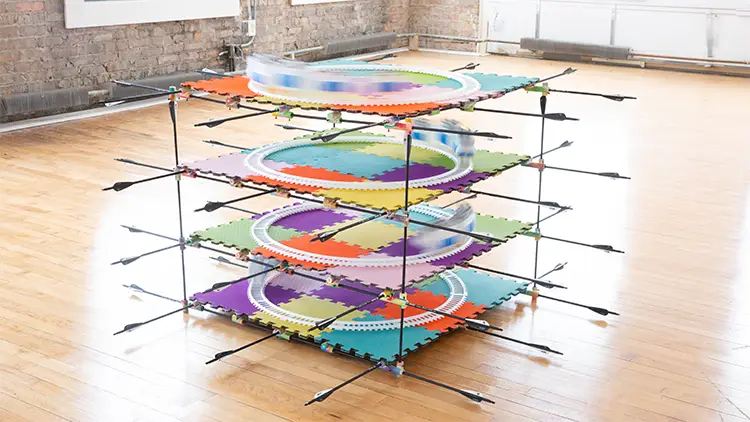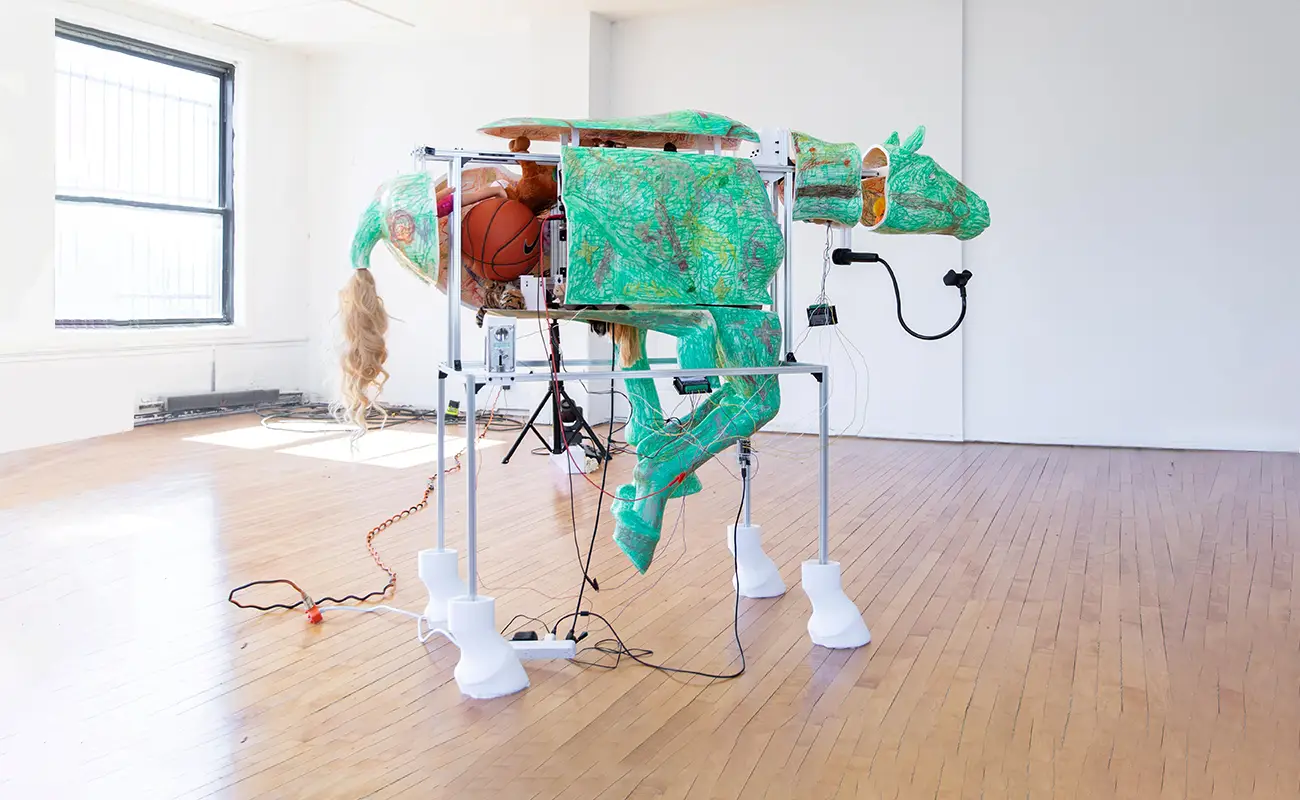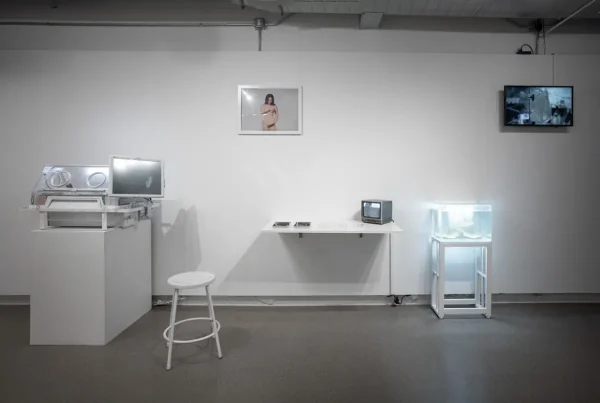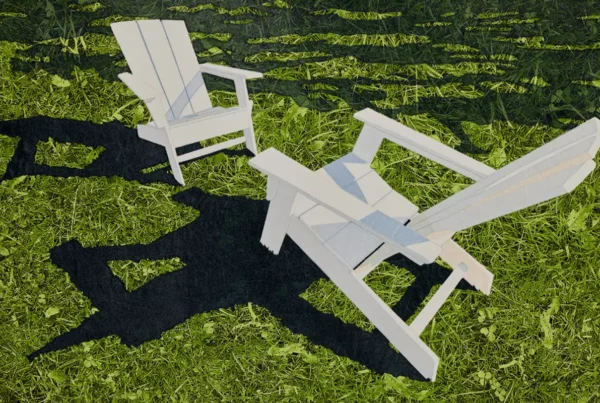“I wanted to be an artist because I am a nervous person… and I wanted to make them go away, sort of like deflating these things.”
Crafting Shock Into Play — The Origins of an Artistic Instinct
The work of Zj Pan resides in a charged intersection between the surreal and the sincere, where daily life’s most peculiar disturbances are transformed into strange, poignant creations. As an interdisciplinary artist working primarily in sculpture, performance, and garment design, Pan captures the often-overlooked strangeness embedded in contemporary routines. His approach draws heavily from personal experiences and objects that have emotionally jarred him — including artifacts as disparate as missiles, Apple’s AirPods, and melancholic plush toys. Rather than forming a linear narrative, his artworks echo the nonlinear thought processes of childhood, merging spontaneous impulses with bursts of intellectual critique. Pan’s work resists simplification, opting instead to recreate the emotional residue of a world that is both absurd and eerily familiar.
Rather than channeling a fixed cultural heritage or set of personal themes, Pan allows his transient lifestyle to shape his artistic rhythm. Having moved frequently since adolescence, he developed a sense of temporal displacement that reflects in his artistic output. Home, for him, is an abstract notion rather than a physical location, and that ambiguity threads itself through his installations. Pan doesn’t anchor his work to specific narratives or ideologies; instead, he reacts instinctively to his present circumstances, making each project a response to the moment rather than a reflection of a long-term ideology. This immediate way of working emphasizes presence, making his artistic process less about grand theories and more about personal confrontation with what feels urgent and strange.
What led Pan into the arts wasn’t a straightforward passion but a visceral reaction to the complexities and contradictions of modern life. Navigating the overwhelming flood of news, myths, and mediated narratives left him feeling anxious and overexposed — a reaction that fueled his need to make things, to deflate these sources of discomfort. In his words, becoming an artist was a way of reclaiming space through play. That commitment to playful resistance took root during his undergraduate years, when he served as a creative director for a fashion magazine. Immersed in a dynamic creative network, he found his footing by participating in early exhibitions and later solidified his path with an MFA from the School of the Art Institute of Chicago. The pivotal moment came with his graduate showcase, where his work garnered enough attention to lead to a major solo show at Facility, curated by artist Nick Cave — an affirmation that his eccentric yet potent voice had found its audience.
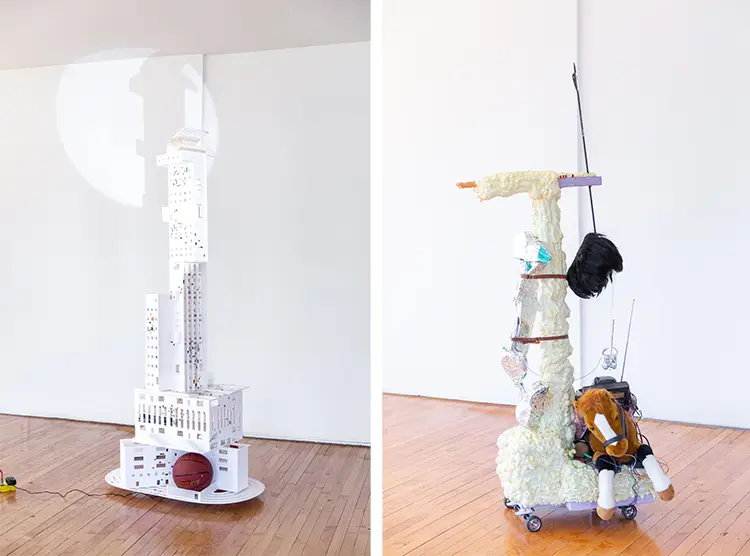
Zj Pan: Interacting With the Uncomfortable Giggle
Pan’s visual language veers into a terrain both whimsical and unnerving, often operating with a sensibility that turns discomfort into an invitation to laugh — even if nervously. He treats familiar objects with exaggerated affection and distortion, reconfiguring them into what he describes as “child’s half-finished thoughts.” His sculptural techniques are raw and DIY-inspired, where digital engineering collides with hand-drawn crayon textures and absurd compositions. This aesthetic choice enhances the surreal tone of his work, placing the viewer in an imaginative but disquieting playground. He leans into an emotional space where humor and disturbance share the same stage, pushing his audience to confront their reactions as part of the artwork itself.
Themes in Pan’s work vary widely, but they are all grounded in their proximity to his lived experience. War, sexuality, mythologies, consumerism, and daily anxiety become intertwined, not as abstract academic exercises but as emotionally entangled presences in his life. Instead of isolating these themes into standalone subjects, he weaves them into his own perceptions and habits. This self-oriented approach makes his work feel intimate even when it deals with large-scale concerns like geopolitical violence. Often incorporating fetishistic or absurd elements, his installations do not aim to offer clean commentary but rather act as distorted mirrors — reflecting the confusion, fear, and bizarre humor that define modern existence.
Among his influences, Bruce Nauman stands out as a guiding presence. Pan admires Nauman’s breadth and refusal to tether himself to a single artistic form or theme. He sees in his work a kind of freedom that reassures him — that art can be reactive, spontaneous, and rooted in intuitive gestures. Nauman’s “One Hundred Fish Fountain” is a piece he especially reveres, and he openly fantasizes about replicating it for himself. His approach resonates deeply with Pan’s own sensibilities, not only because of his thematic ambiguity but because of the way he treats art as something inseparable from life itself. For Pan, Nauman’s oeuvre functions as a conceptual barometer — a way to measure and calibrate the emotional tone of his own artistic explorations.
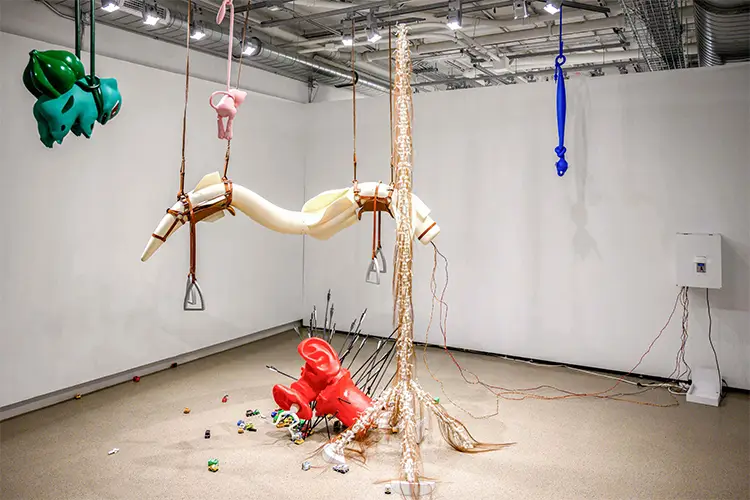
The Horse, the Missile, and the Vending Machine of Desire
A defining piece in Pan’s growing body of work is Ox-Head, a sculpture that captures many of the contradictions and obsessions that populate his artistic world. The genesis of the piece came from a thought experiment: if the missile is a modern equivalent of the horse — a symbol of conquest — then what happens when the horse returns in a different skin? Drawing from history, myth, and personal symbolism, he looked to the figure of Ox-Head, both as Alexander the Great’s fabled steed and as a gatekeeper in Chinese mythology. The result was a hybrid creature that layered themes of sexuality, war, power, and myth into one grotesquely enchanting figure. It became a repository for everything he loved and loathed about these overlapping concepts.
What makes Ox-Head particularly striking is its layered interactivity. The sculpture doesn’t merely sit passively in a space — it dispenses edible AirPods and baby missiles crafted from isomalt sugar. These items are sold from the body of the horse itself, transformed into a vending machine. With each transaction, the viewer physically participates in the symbolic consumption of war, consumerism, and media, tying the artwork’s themes directly to their own behavior. The crayon-forged bronze patina further mocks the grandeur often associated with equestrian statues, turning historical motifs into ironic gestures. The inclusion of Apple AirPods speaks to how modern conflict is consumed — wirelessly, remotely, without physical engagement. By embedding these within the horse’s belly, Pan critiques not only the machinery of war but the seductive ways it’s delivered to us.
The complexity of Ox-Head lies in its refusal to pick a side. It is simultaneously beautiful and grotesque, playful and deeply serious. Pan’s decision to include a circus within the body of the sculpture amplifies this duality, suggesting that within every act of conquest or destruction lies a bizarre theater of performance and absurdity. The work resonated with viewers not just for its aesthetic or conceptual power, but because it felt strangely personal — a sculpture that seems to look back at you, reflecting the contradictions you carry. For Pan, the significance of Ox-Head is as straightforward as it is profound: he likes it, and that satisfaction affirms his process. It’s a rare declaration of artistic contentment that punctuates a practice otherwise defined by discomfort and distortion.
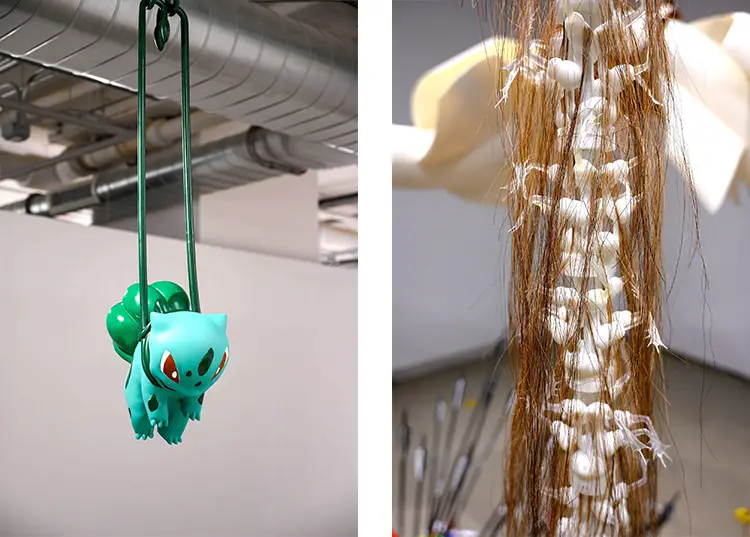
Zj Pan: Sculpting Memory and Ego From Plastic and Play
Objects, for Pan, are more than passive materials — they are witnesses, companions, and memory holders. He describes his deep attachment to physical things with the kind of intimacy often reserved for people. Most of the furniture in his space was given by friends, becoming emotional anchors in an otherwise nomadic life. This affection translates directly into his artistic choices, where sculptures become vessels of personal connection rather than symbolic abstractions. Objects are trustworthy because they are present, he notes; they don’t pretend to be anything more than what they are. In this understanding, sculpture becomes not just a medium but an extension of his daily experience, a way to process emotional fragments through physical engagement.
Though sculpture remains his primary focus, Pan’s creative reach spans performance, video, and fashion. Often, these mediums converge in layered installations. One notable piece involved a performance where he consumed candy replicas of AirPods and spat them into molds shaped like Pokémon. The resultant objects were frozen inside a fridge and exhibited alongside a video of the act, blurring the lines between performance, object-making, and documentation. This composite approach gives his work a sense of lifecycle — from act to artifact — and underscores his belief that no single medium can fully encapsulate the ideas he explores. With a background in fashion, he brings technical precision to his garment work, treating clothes not merely as wearable art but as emotional armor or extensions of identity.
More recently, Pan has turned his attention to plastic — a material he describes as the physical embodiment of the human ego. Its malleability and ubiquity make it a fitting medium to address the contradictions of the contemporary world. Plastic, in his eyes, produces imperfect copies, and it is this very imperfection that makes it so resonant. In choosing plastic, he confronts the artificiality and theatricality that define modern existence, while also embracing its potential to transform. Whether through sugar-cast missiles or wearable sculptures, Pan continues to mold emotional discomfort into vivid, participatory experiences that blur boundaries and invite reflection. His work is not an answer, but an invitation — to feel, to question, and most importantly, to play.
